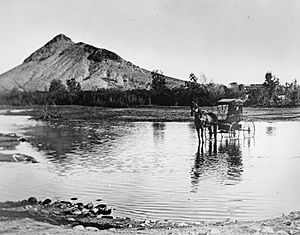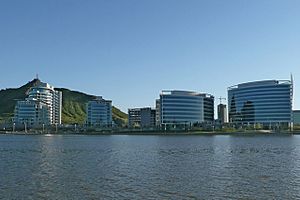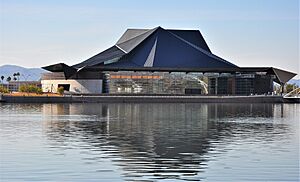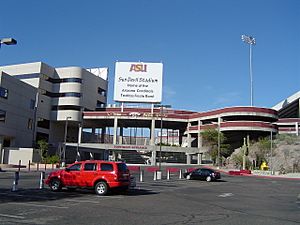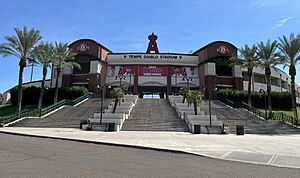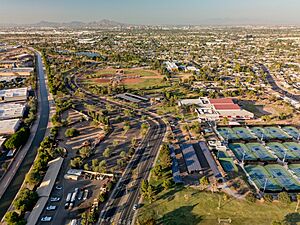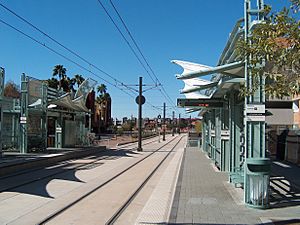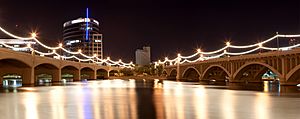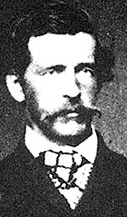Tempe, Arizona facts for kids
Quick facts for kids
Tempe
O'odham: Oidbaḍ
|
||
|---|---|---|
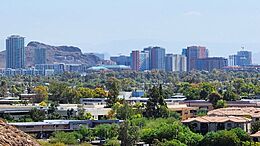
Tempe skyline as seen from The Buttes
|
||
|
||
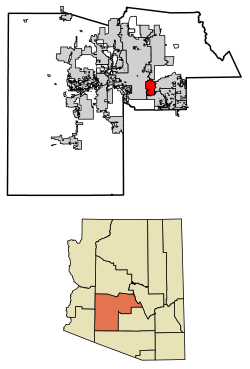
Location of Tempe in Maricopa County, Arizona
|
||
| Country | United States | |
| State | Arizona | |
| County | Maricopa | |
| Incorporated | October 15, 1892 | |
| Named for | Vale of Tempe | |
| Government | ||
| • Body | Tempe City Council | |
| Area | ||
| • City | 40.15 sq mi (103.99 km2) | |
| • Land | 39.94 sq mi (103.45 km2) | |
| • Water | 0.21 sq mi (0.54 km2) | |
| Elevation | 1,181 ft (360 m) | |
| Population
(2020)
|
||
| • City | 180,587 | |
| • Rank | US: 140th | |
| • Density | 4,521.34/sq mi (1,745.72/km2) | |
| • Metro | 4,574,531 (US: 12th) | |
| • Demonym | Tempean | |
| Time zone | UTC−7 (MST (no DST)) | |
| ZIP code |
85281–85285, 85287-85288
|
|
| Area codes | 480 and 602 | |
| FIPS code | 04-73000 | |
| GNIS feature ID | 2412045 | |
Tempe (pronounced tem-PEE) is a lively city in Maricopa County, Arizona, United States. In 2020, about 180,587 people lived there. The city gets its name from the beautiful Vale of Tempe in Greece.
Tempe is part of the larger Phoenix metropolitan area. It is surrounded by other cities like Phoenix, Guadalupe, Scottsdale, Chandler, and Mesa. Tempe is also home to the main campus of Arizona State University, a very large and well-known college.
Contents
- Exploring Tempe's Past: A City's Journey
- Tempe's Location and Landscape
- Who Lives in Tempe?
- Tempe's Economy and Businesses
- Arts and Culture in Tempe
- Sports in Tempe
- Parks and Outdoor Fun
- Learning and Education
- Media and News
- Getting Around Tempe
- Famous People from Tempe
- Sister Cities Around the World
- Images for kids
- See also
Exploring Tempe's Past: A City's Journey
Long ago, the Hohokam people lived in this area. They were skilled farmers who built many canals to water their crops. They left their settlements around the 1400s, but some families stayed nearby.
In 1865, Fort McDowell was built about 25 miles northeast of where downtown Tempe is today. This fort helped new towns grow along the Salt River. Soldiers and workers started small camps near the river to grow food for the fort. These camps were the first lasting communities in the Valley after the Hohokam left.
Two of these early settlements were 'Hayden's Ferry' and 'San Pablo'. Hayden's Ferry was named after a ferry service run by Charles T. Hayden, which became an important way to cross the river. Soon, the Tempe Irrigating Canal Company was created to bring water to farms growing crops like alfalfa, wheat, and cotton.
The name "Tempe" was suggested in 1879 by a pioneer named Darrell Duppa. He thought the Salt River valley, with its 300-foot-tall butte, looked like the Vale of Tempe near Mount Olympus in Greece.
In 1885, Tempe was chosen as the location for the Territorial Normal School. This school grew over the years and is now Arizona State University.
The Maricopa and Phoenix Railroad was built in 1887. It crossed the Salt River at Tempe, connecting the town to the rest of the country. Tempe quickly became an important center for farming. The town of Tempe officially became a city in 1894.
In 1911, the Roosevelt Dam was finished. This dam made sure there was enough water for all the growing farms in the Valley. Former President Theodore Roosevelt visited to celebrate the dam and predicted that the towns in central Arizona would become successful cities. Soon after, Arizona became the 48th state.
On August 30, 1971, a rare F2 tornado hit Tempe. It injured 41 people and caused about $3 million in damage. One person sadly passed away from a heart attack during the storm.
In recent times, Tempe has grown into a busy suburb of Phoenix. It is also a major center for education and business.
Tempe's Location and Landscape
Tempe is a city located right between Phoenix and the rest of the East Valley. Because it's home to Arizona State University, the northern part of Tempe is quite busy and urban, especially near the Valley Metro Line train. As you go south, the city becomes less crowded, with more homes and shopping areas.
The Salt River flows through the northern part of Tempe. Parts of the river have been dammed to create Tempe Town Lake. This lake is a popular spot for fun activities.
Tempe covers about 40.2 square miles, with most of it being land. The city is bordered by Mesa to the east, Scottsdale to the north, Phoenix to the west, and Chandler to the south.
The city is mostly flat, but there are a few hills. The most famous is Tempe Butte, also known as A-Mountain because of the "A" logo for Arizona State University on its side. Other hills include Twin Buttes, Bell Butte, and the buttes in Papago Park. The lowest point in Tempe is at Tempe Town Lake, and the highest is on top of Hayden Butte.
Tempe's Weather: A Desert Climate
Tempe has a desert climate. This means it gets very hot and dry, especially in the summer. It also has a bigger difference between daytime and nighttime temperatures compared to nearby Phoenix.
| Climate data for Tempe, Arizona, 1991–2020 normals, extremes 1948–present | |||||||||||||
|---|---|---|---|---|---|---|---|---|---|---|---|---|---|
| Month | Jan | Feb | Mar | Apr | May | Jun | Jul | Aug | Sep | Oct | Nov | Dec | Year |
| Record high °F (°C) | 87 (31) |
92 (33) |
99 (37) |
105 (41) |
113 (45) |
119 (48) |
118 (48) |
119 (48) |
115 (46) |
108 (42) |
98 (37) |
88 (31) |
119 (48) |
| Mean maximum °F (°C) | 80.2 (26.8) |
83.2 (28.4) |
90.6 (32.6) |
98.0 (36.7) |
104.1 (40.1) |
110.5 (43.6) |
112.2 (44.6) |
110.8 (43.8) |
107.5 (41.9) |
100.7 (38.2) |
89.9 (32.2) |
79.9 (26.6) |
113.1 (45.1) |
| Mean daily maximum °F (°C) | 70.6 (21.4) |
73.7 (23.2) |
80.4 (26.9) |
86.9 (30.5) |
95.0 (35.0) |
103.7 (39.8) |
105.9 (41.1) |
104.8 (40.4) |
100.8 (38.2) |
91.0 (32.8) |
79.0 (26.1) |
69.3 (20.7) |
88.4 (31.3) |
| Daily mean °F (°C) | 54.5 (12.5) |
57.3 (14.1) |
63.1 (17.3) |
68.9 (20.5) |
77.1 (25.1) |
85.3 (29.6) |
90.9 (32.7) |
89.9 (32.2) |
84.9 (29.4) |
73.6 (23.1) |
62.0 (16.7) |
53.5 (11.9) |
71.8 (22.1) |
| Mean daily minimum °F (°C) | 38.5 (3.6) |
40.9 (4.9) |
45.9 (7.7) |
50.9 (10.5) |
59.1 (15.1) |
67.0 (19.4) |
75.8 (24.3) |
75.1 (23.9) |
68.9 (20.5) |
56.3 (13.5) |
45.1 (7.3) |
37.7 (3.2) |
55.1 (12.8) |
| Mean minimum °F (°C) | 30.5 (−0.8) |
33.8 (1.0) |
37.8 (3.2) |
42.5 (5.8) |
51.4 (10.8) |
60.3 (15.7) |
68.7 (20.4) |
68.6 (20.3) |
60.3 (15.7) |
46.7 (8.2) |
36.0 (2.2) |
29.5 (−1.4) |
27.4 (−2.6) |
| Record low °F (°C) | 16 (−9) |
19 (−7) |
24 (−4) |
30 (−1) |
35 (2) |
45 (7) |
53 (12) |
52 (11) |
45 (7) |
26 (−3) |
23 (−5) |
20 (−7) |
16 (−9) |
| Average precipitation inches (mm) | 1.04 (26) |
1.12 (28) |
0.96 (24) |
0.23 (5.8) |
0.18 (4.6) |
0.06 (1.5) |
0.99 (25) |
1.30 (33) |
0.71 (18) |
0.61 (15) |
0.65 (17) |
0.95 (24) |
8.80 (224) |
| Average precipitation days (≥ 0.01 in) | 4.4 | 4.5 | 3.3 | 1.3 | 1.2 | 0.6 | 3.7 | 4.5 | 2.9 | 2.3 | 2.0 | 3.6 | 34.3 |
| Source 1: NOAA | |||||||||||||
| Source 2: National Weather Service | |||||||||||||
Who Lives in Tempe?
Tempe is a diverse city with people from many different backgrounds. The population has grown a lot over the years. In 1880, only 135 people lived here, but by 2020, the population was over 180,000!
| Race / Ethnicity (NH = Non-Hispanic) | Pop 2000 | Pop 2010 | Pop 2020 | % 2000 | % 2010 | % 2020 |
|---|---|---|---|---|---|---|
| White alone (NH) | 110,517 | 100,711 | 97,651 | 69.67% | 62.28% | 54.07% |
| Black or African American alone (NH) | 5,546 | 9,021 | 11,393 | 3.50% | 5.58% | 6.31% |
| Native American or Alaska Native alone (NH) | 2,678 | 3,870 | 4,357 | 1.69% | 2.39% | 2.41% |
| Asian alone (NH) | 7,405 | 9,035 | 17,169 | 4.67% | 5.59% | 9.51% |
| Pacific Islander alone (NH) | 425 | 618 | 688 | 0.27% | 0.38% | 0.38% |
| Some Other Race alone (NH) | 244 | 312 | 939 | 0.15% | 0.19% | 0.52% |
| Mixed Race or Multi-Racial (NH) | 3,337 | 4,060 | 8,692 | 2.10% | 2.51% | 4.81% |
| Hispanic or Latino (any race) | 28,473 | 34,092 | 39,698 | 17.95% | 21.08% | 21.98% |
| Total | 158,625 | 161,719 | 180,587 | 100.00% | 100.00% | 100.00% |
In 2010, there were about 161,719 people living in Tempe. Many different groups make up the city's population. About 21.2% of the people were Hispanic or Latino.
The average age in Tempe was 29 years old. This is because many young people attend Arizona State University.
Tempe's Economy and Businesses
Tempe is a hub for many businesses and companies. Several large companies have their main offices here, including DriveTime, Carvana, GoDaddy, and First Solar. Even the popular ice cream chain Cold Stone Creamery started in Tempe!
The city helps new businesses grow with programs like FABRiC (Fashion and Business Resource Innovation Center) and BRiC (Business Resource and Innovation Center).
Tempe is also famous for being home to the largest campus of Arizona State University. The city used to host the Fiesta Bowl, a big college football game, and now hosts the Cactus Bowl.
You can find many places for entertainment in Tempe. These include Gammage Auditorium and the Tempe Center for the Arts.
Tempe Town Lake is a popular spot for big events, like the Ironman Arizona and Rock 'n' Roll Marathon. Gammage Auditorium even hosted a presidential debate in 2004! The Los Angeles Angels baseball team also does their spring training in Tempe.
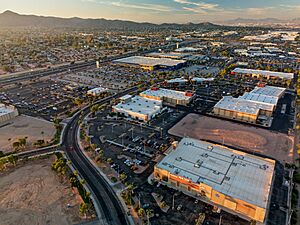
Tempe has great shopping too. Arizona Mills is one of Arizona's biggest malls. The first IKEA store in Arizona is also located here. Tempe Marketplace is a large outdoor mall with live music and shows. Mill Avenue, near Hayden Butte, is a busy area with shops, restaurants, and entertainment, especially popular with students.
Major Employers in Tempe
Many people work in Tempe. Here are some of the biggest employers in the city:
| # | Employer | Employees |
|---|---|---|
| 1 | Arizona State University | 8,010 |
| 2 | State Farm Insurance | 6,550 |
| 3 | Freedom Financial Network | 2,300 |
| 4 | JPMorgan Chase Bank National Association | 2,220 |
| 5 | ABM Industries Inc | 2,000 |
| 6 | City of Tempe | 1,983 |
| 7 | Honeywell | 1,540 |
| 8 | Total Events Management LLC | 1,040 |
| 9 | Wells Fargo | 1,030 |
| 10 | ADP Inc | 1,000 |
| 10 | Bank of the West | 1,000 |
Arts and Culture in Tempe
Tempe offers many ways to enjoy art, music, and history.
Tempe Center for the Arts: A Creative Hub
The Tempe Center for the Arts (TCA) opened in 2007. It's a beautiful place for performing and visual arts. It has a large theater with 600 seats, a smaller studio theater, a multi-purpose space, and an art gallery.
Tempe History Museum: Discover the Past
The Tempe History Museum helps visitors learn about the city's past. It has collections, exhibits, and programs that tell Tempe's story.
Public Art: Art Around the City
Tempe has a Public Art Program that works with artists to create art for public spaces. Since 1988, more than 50 art projects have been added to the city. You can find many sculptures and art pieces as you explore Tempe.
Live Music Scene: Tempe's Sound
Tempe was well-known for its alternative music scene in the 1980s and 90s. Many famous bands, like the Gin Blossoms and Meat Puppets, started here. You can still find live music at places like the Yucca Tap Room.
Tempe Music Walk: Honoring Musical Talent
The Tempe Music Walk celebrates local musicians and venues. Plaques are placed in the sidewalk on Mill Avenue to honor artists like Walt Richardson and The Gin Blossoms.
Public Libraries: A Place to Read and Learn
The Tempe Public Library is where you can find books and resources. It's located right next to the Tempe History Museum.
Tourism: Visiting Tempe
Many people visit Tempe for its events and attractions. Popular reasons to visit include the Rock 'n' Roll Arizona Marathon, Tempe Marketplace, Arizona Mills, Mill Avenue, and Tempe Town Lake. The Tempe Tourism Office can help visitors find maps and information about hotels and events.
Sports in Tempe
Tempe has a rich sports history. From 1988 to 2005, the National Football League's Arizona Cardinals played at Sun Devil Stadium. While the Cardinals moved to Glendale, their headquarters and training facility are still in Tempe.
The Arizona State University Sun Devils are a big part of Tempe's sports scene. They compete in many sports like football, basketball, and baseball in the Big 12 Conference. Their football team plays at Sun Devil Stadium. The Sun Devils' main rival is the University of Arizona Wildcats.
The Los Angeles Angels baseball team holds their spring training at Tempe Diablo Stadium. This stadium has 9,785 seats and was built in 1968. The Angels have been training in Tempe since 1993.
The Arizona Coyotes ice hockey team played at Mullett Arena in Tempe for a couple of seasons, but they have since moved to Salt Lake City, Utah.
Rugby union is also growing in Tempe. There are several rugby clubs for men, women, college students, and younger players.
Parks and Outdoor Fun
Tempe offers many outdoor activities for everyone to enjoy.
Tempe Town Lake is a public lake managed by the City of Tempe. It's a great place for recreation and also helps protect the area from floods. In 2013, about 2.7 million people visited the lake!
Papago Park and Tempe Butte Desert Preserves are perfect for hiking, biking, rock climbing, and even disc golf. Tempe also hosts the annual Ironman Triathlon in November, a challenging race that includes swimming, biking, and running.
Tempe has over 50 parks. Some popular ones include Kiwanis Park, Tempe Beach Park, and Tempe Sports Complex. Kiwanis Park has Kiwanis Lake, an indoor wave pool, a gym, batting cages, and tennis courts.
Learning and Education
Tempe has many schools and colleges. Most of the city is served by the Tempe Elementary School District and the Tempe Union High School District. Other parts are covered by the Kyrene School District, Scottsdale Unified School District, and Mesa Public Schools. There are also private schools like James Madison Preparatory School and Tempe Preparatory Academy.
Arizona State University is one of the largest universities in the country and is known for its research and new ideas, especially in science. Tempe is also home to other colleges like the University of Phoenix and Rio Salado Community College.
Media and News
Tempe has its own local TV channel, Tempe 11, on Cox Cable Channel 11. Several radio stations are located in Tempe, including KJZZ (an NPR station) and KBAQ (a classical music station). Sun Sounds, a radio station for people who are blind, is also here. Local newspapers like the Tempe Tribune and Tempe Independent cover news in the city.
Getting Around Tempe
Tempe is a busy city, and it's easy to get around. Major freeways like Interstate 10, Loop 202, Loop 101, and U.S. Route 60 connect Tempe to other parts of the Valley.
Valley Metro offers bus routes and a light rail system that serves Downtown Tempe and Arizona State University. This rail system connects Tempe to Phoenix and Mesa. The City of Tempe also has free shuttle services called Orbit and FLASH that run around the university area. Many people in Tempe use public transportation.
Phoenix Sky Harbor International Airport is only about 2 miles northwest of Tempe, offering flights to many places. Phoenix-Mesa Gateway Airport is also nearby.
Tempe is one of the few cities that allows self-driving taxis. Waymo offers this service in most parts of the city.
In 2023, Tempe opened the nation's first "zero-driving community" called Culdesac Tempe. Residents living here agree not to own a car and instead use public transport, which is included in their rent. This project aims to create a community where people don't need cars to get around.
Famous People from Tempe
Many notable people have connections to Tempe, including:
- Roger Clyne – a musician
- Norman Dubie – a poet
- Grady Gammage – a former president of ASU
- Gin Blossoms – a famous rock band
- Carl T. Hayden – a U.S. Senator who was born in Tempe
- Katie Hobbs – the current governor of Arizona
- The Meat Puppets – another well-known rock band
- The Refreshments – an alternative rock band
- Alberto Ríos – a poet
Sister Cities Around the World
Tempe has "sister city" relationships with several cities around the world. These partnerships help promote cultural understanding and friendship.
 Beaulieu-sur-Mer, France
Beaulieu-sur-Mer, France Carlow, Ireland
Carlow, Ireland Lower Hutt, New Zealand
Lower Hutt, New Zealand Regensburg, Germany
Regensburg, Germany Skopje, North Macedonia
Skopje, North Macedonia Zhenjiang, China
Zhenjiang, China Timbuktu, Mali
Timbuktu, Mali Cuenca, Ecuador
Cuenca, Ecuador Cuzco, Peru
Cuzco, Peru Trollhättan, Sweden
Trollhättan, Sweden Agra City, India
Agra City, India
The newest sister city is Agra City, India, which joined in 2016.
Images for kids
See also
 In Spanish: Tempe (Arizona) para niños
In Spanish: Tempe (Arizona) para niños





